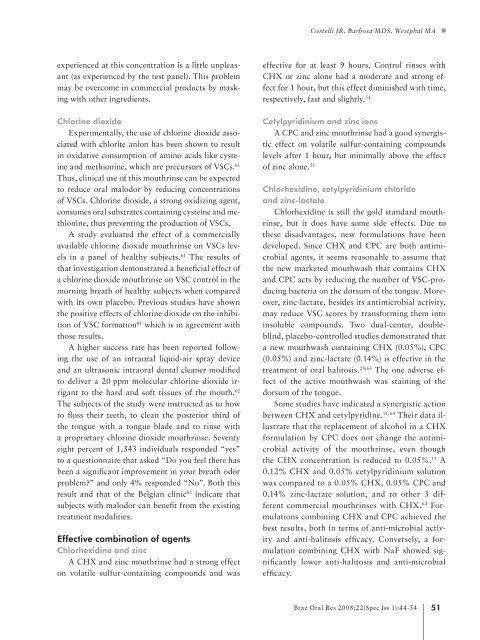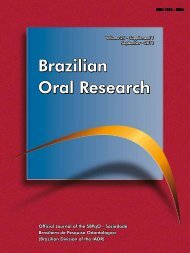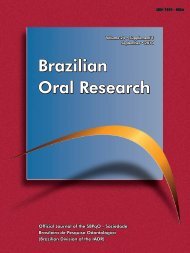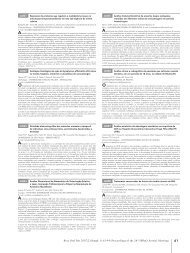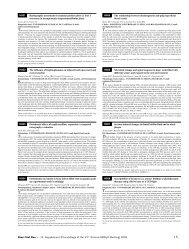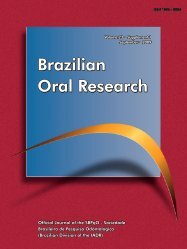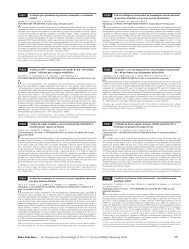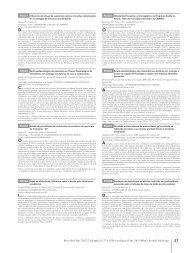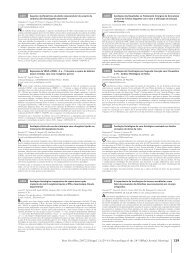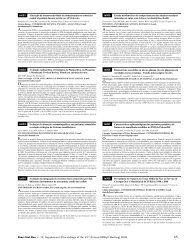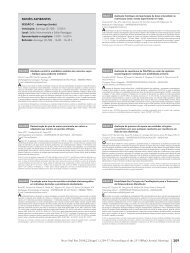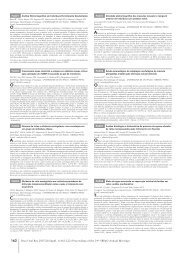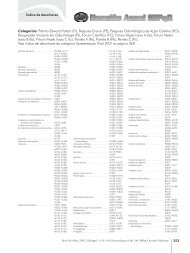Brazilian Oral Research Brazilian Oral Research Brazilian Oral
Brazilian Oral Research Brazilian Oral Research Brazilian Oral
Brazilian Oral Research Brazilian Oral Research Brazilian Oral
You also want an ePaper? Increase the reach of your titles
YUMPU automatically turns print PDFs into web optimized ePapers that Google loves.
experienced at this concentration is a little unpleasant<br />
(as experienced by the test panel). This problem<br />
may be overcome in commercial products by masking<br />
with other ingredients.<br />
Chlorine dioxide<br />
Experimentally, the use of chlorine dioxide associated<br />
with chlorite anion has been shown to result<br />
in oxidative consumption of amino acids like cysteine<br />
and methionine, which are precursors of VSCs. 61<br />
Thus, clinical use of this mouthrinse can be expected<br />
to reduce oral malodor by reducing concentrations<br />
of VSCs. Chlorine dioxide, a strong oxidizing agent,<br />
consumes oral substrates containing cysteine and methionine,<br />
thus preventing the production of VSCs.<br />
A study evaluated the effect of a commercially<br />
available chlorine dioxide mouthrinse on VSCs levels<br />
in a panel of healthy subjects. 61 The results of<br />
that investigation demonstrated a beneficial effect of<br />
a chlorine dioxide mouthrinse on VSC control in the<br />
morning breath of healthy subjects when compared<br />
with its own placebo. Previous studies have shown<br />
the positive effects of chlorine dioxide on the inhibition<br />
of VSC formation 61 which is in agreement with<br />
those results.<br />
A higher success rate has been reported following<br />
the use of an intraoral liquid-air spray device<br />
and an ultrasonic intraoral dental cleaner modified<br />
to deliver a 20 ppm molecular chlorine dioxide irrigant<br />
to the hard and soft tissues of the mouth. 62<br />
The subjects of the study were instructed as to how<br />
to floss their teeth, to clean the posterior third of<br />
the tongue with a tongue blade and to rinse with<br />
a proprietary chlorine dioxide mouthrinse. Seventy<br />
eight percent of 1,343 individuals responded “yes”<br />
to a questionnaire that asked “Do you feel there has<br />
been a significant improvement in your breath odor<br />
problem?” and only 4% responded “No”. Both this<br />
result and that of the Belgian clinic 62 indicate that<br />
subjects with malodor can benefit from the existing<br />
treatment modalities.<br />
Effective combination of agents<br />
Chlorhexidine and zinc<br />
A CHX and zinc mouthrinse had a strong effect<br />
on volatile sulfur-containing compounds and was<br />
Cortelli JR, Barbosa MDS, Westphal MA<br />
effective for at least 9 hours. Control rinses with<br />
CHX or zinc alone had a moderate and strong effect<br />
for 1 hour, but this effect diminished with time,<br />
respectively, fast and slightly. 51<br />
Cetylpyridinium and zinc ions<br />
A CPC and zinc mouthrinse had a good synergistic<br />
effect on volatile sulfur-containing compounds<br />
levels after 1 hour, but minimally above the effect<br />
of zinc alone. 51<br />
Chlorhexidine, cetylpyridinium chloride<br />
and zinc-lactate<br />
Chlorhexidine is still the gold standard mouthrinse,<br />
but it does have some side effects. Due to<br />
these disadvantages, new formulations have been<br />
developed. Since CHX and CPC are both antimicrobial<br />
agents, it seems reasonable to assume that<br />
the new marketed mouthwash that contains CHX<br />
and CPC acts by reducing the number of VSC-producing<br />
bacteria on the dorsum of the tongue. Moreover,<br />
zinc-lactate, besides its antimicrobial activity,<br />
may reduce VSC scores by transforming them into<br />
insoluble compounds. Two dual-center, doubleblind,<br />
placebo-controlled studies demonstrated that<br />
a new mouthwash containing CHX (0.05%), CPC<br />
(0.05%) and zinc-lactate (0.14%) is effective in the<br />
treatment of oral halitosis. 29,63 The one adverse effect<br />
of the active mouthwash was staining of the<br />
dorsum of the tongue.<br />
Some studies have indicated a synergistic action<br />
between CHX and cetylpyridine. 11,64 Their data illustrate<br />
that the replacement of alcohol in a CHX<br />
formulation by CPC does not change the antimicrobial<br />
activity of the mouthrinse, even though<br />
the CHX concentration is reduced to 0.05%. 11 A<br />
0.12% CHX and 0.05% cetylpyridinium solution<br />
was compared to a 0.05% CHX, 0.05% CPC and<br />
0.14% zinc-lactate solution, and to other 3 different<br />
commercial mouthrinses with CHX. 64 Formulations<br />
combining CHX and CPC achieved the<br />
best results, both in terms of anti-microbial activity<br />
and anti-halitosis efficacy. Conversely, a formulation<br />
combining CHX with NaF showed significantly<br />
lower anti-halitosis and anti-microbial<br />
efficacy.<br />
Braz <strong>Oral</strong> Res 2008;22(Spec Iss 1):44-54<br />
1


